"Homogenization" covers various processes that simply define the mixing of materials that may be compatible or incompatible. A common example is homogenized milk, which is achieved by dispersing heavier cream into more liquid milk to provide uniformity and prevent separation during storage. A more extensive definition involves mixing challenges that cannot be achieved with the best mixing methods. In these cases, homogenization using a laboratory homogenizer may involve relevant processing steps, such as emulsifying, dispersing, dissolving, and breaking solids, liquids, and gases into other media.

"Dispersion" is used to define how equipment is used for homogenization. The recommended device for most laboratory and pilot plant applications is the homogenizer system, which consists of a driving unit and various homogenization rotor-stator configurations, collectively referred to as a homogenization generator. Three universal dispersions have been identified:
(1) Gas to liquid to produce foam.
(2) Solid to liquid, such as pigments in paints and varnishes.
(3) Processing immiscible liquids, such as oil and water.
The bottom of the rotor shaft fixed on the drive motor is machined with sharp edges to complement the fixed stator fixed on the drive motor shell. The bottom of the laboratory homogenizer stator is also machined with sharp edges. When the material is sucked into the generator component and the working area between the rotor and stator, the material is evenly distributed due to the combined action of mechanical shear force and acoustic energy. The production size of the rotor and stator generator components can handle materials from test tubes to beakers. They are designed to treat or perform specific functions according to the type of sample being processed, including viscous or rough samples, low-viscosity materials, aqueous media, and cutting edges.
The rotor-stator assembly can be interchanged using the supplied rotor wrench, allowing researchers to perform multiple dispersion experiments with the same drive motor. There are several power ratings for the drive motor, which are selected depending on the volume and physical characteristics of the processed material. These variable speed motors should be started at the lowest speed and gradually increased to the desired speed to help avoid sample splashing from the container. Except for the drive motor designed to be handheld, all drive motors should be firmly mounted on an adjustable mounting system to stably secure them in the beaker or flask.
Other applications of lab homogenizers use special attachments to crush solid samples for further processing and provide closed-loop or online processing. The former is processed by a grinder, and the latter is processed by encapsulating the rotor-stator configuration in one of two circulating chamber models. These attachments should be used with higher-power drive motors. Learn more about other lab automation equipment produced by Raykolgroup.